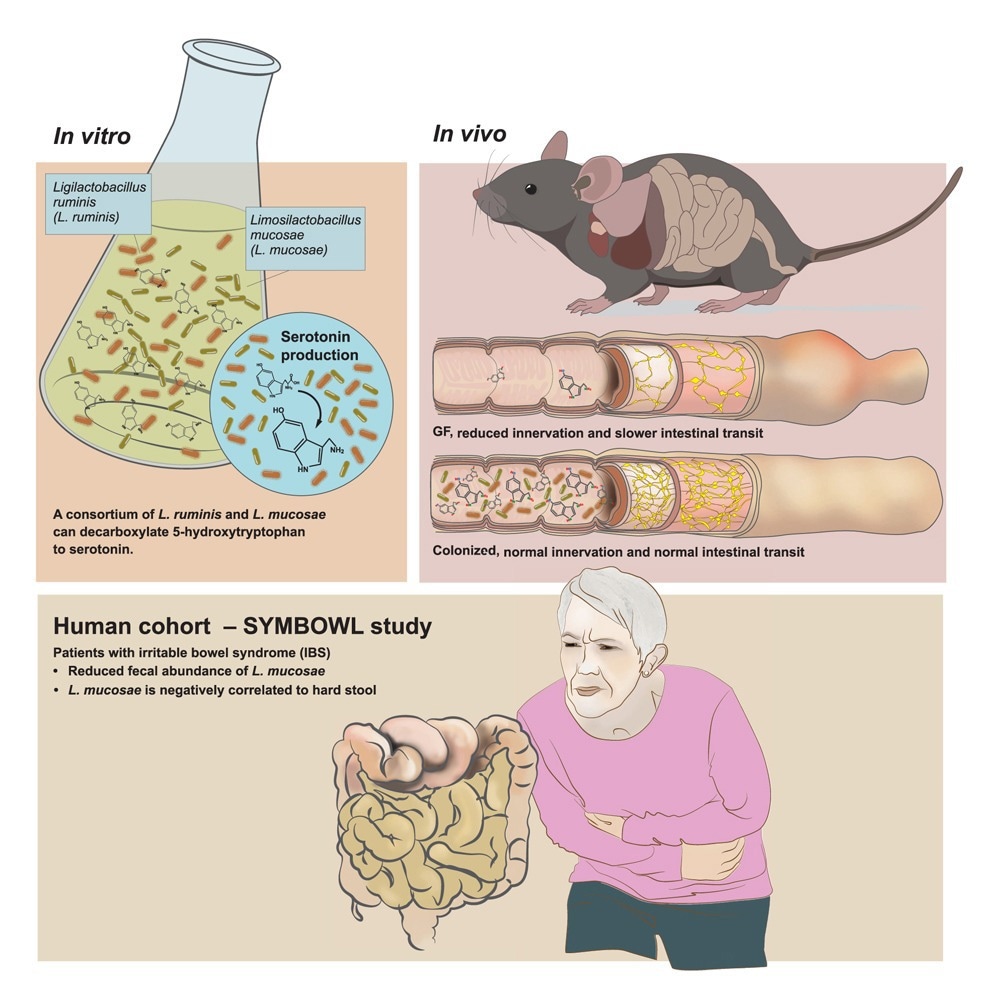Scientists have discovered two human gut microbes that generate serotonin, revealing how microbial chemistry can shape gut movement and nerve connectivity, and opening new possibilities for treating intestinal disorders like IBS.

Study: Identification of human gut bacteria that produce bioactive serotonin and promote colonic innervation
In a recent study published in the journal Cell Reports, researchers identified human gut commensals that decarboxylate 5-hydroxytryptophan (5-HTP) to produce serotonin.
Serotonin is an important signaling molecule in the intestine, mediating gastrointestinal functions, such as vasodilation, visceral sensitivity, and peristalsis. Aberrant serotonin signaling is implicated in IBS pathogenesis. The gut accounts for about 95% of the body’s serotonin pool. Mammalian enterochromaffin cells produce serotonin from tryptophan (Trp).
Studies have demonstrated that the gut microbiota modulates host serotonin production by increasing Tph1 expression. Gut microbiota perturbation using antibiotics has been shown to decrease colonic Tph1 expression and serotonin levels. While serotonin has been detected in culture media of facultative anaerobes, including Escherichia coli, evidence for microbial production of serotonin in the gut is lacking. However, in this study, microbial serotonin arose from decarboxylation of 5-HTP rather than hydroxylation of Trp to 5-HTP.
The study and findings
The present study identified human gut commensal bacteria that produce serotonin. First, the researchers compared serum and fecal serotonin levels in Tph1-deficient (Tph1-/-) and wild-type (Tph1+/+) conventionally raised (CONV-R) and germ-free (GF) mice. Both serum and fecal serotonin levels were lower in Tph1-/- relative to Tph1+/+ CONV-R mice. Tph1+/+ GF mice had lower serotonin levels than Tph1+/+ CONV-R mice.
While serum serotonin levels were not different between Tph1-/- CONV-R and GF mice, fecal serotonin levels were higher in Tph1-/- CONV-R mice than in GF counterparts. Further, Tph1-/- GF mice were conventionalized with cecum contents from Tph1+/+ CONV-R mice. This significantly increased fecal serotonin levels in conventionalized mice relative to Tph1-/- GF mice, indicating that the gut microbiota produces serotonin.
Next, fecal microbiota from six individuals were anaerobically cultured, and serotonin was quantified. Serotonin was produced in the growth medium, reaching peak levels within the first 12 hours of inoculation. Further, the researchers isolated bacteria from the stools of healthy individuals to identify strains producing serotonin. Several consortia containing at least one species that can metabolize Trp were isolated and cultured.
Only two consortia (Ls and h1L12h) synthesized detectable serotonin. Genomic analysis identified two species in Ls and seven in h1L12h. Limosilactobacillus mucosae and Ligilactobacillus ruminis were present in both Ls and h1L12h. Other consortia lacked one or both species. Next, the team investigated whether these two species produced serotonin in monocultures. These species were isolated as pure cultures in a nutrient-rich broth.
However, no serotonin production was detected in aerobic or anaerobic conditions, suggesting that interactions between the two species may be required for serotonin synthesis. Consistent with this, serotonin and tryptamine production occurred in the co-isolated community and not in monocultures or simple co-cultures in vitro, although the reconstituted pair increased fecal serotonin in vivo. The study further confirmed that the L. mucosae strain encoded a tryptophan decarboxylase gene, which was cloned and functionally validated as capable of producing tryptamine from Trp and serotonin from 5-HTP.
Further experiments revealed that the two co-isolated lactobacilli produce tryptamine and serotonin in vitro by the decarboxylation of Trp and 5-hydroxytryptophan (5-HTP), respectively. Serotonin was not produced from Trp; 5-HTP was required. Decarboxylation occurred in vitro in microbial communities and not in monocultures.
Next, the team colonized Tph1-/- GF mice with Ls, which increased fecal levels of tryptamine and serotonin and serotonin immunoreactivity in colonic tissue but did not alter serum serotonin levels, indicating a local rather than systemic effect.
Monocolonization with L. mucosae or L. ruminis did not increase fecal serotonin, but reconstituted Ls colonization increased fecal serotonin levels. Further, the researchers assessed whether Ls colonization affects colonic innervation, and stained proximal colon sections from GF and Ls-colonized Tph1-/- mice with Tuj1, a pan-neural marker. This showed an increased Tuj1-immunoreactive area in the Ls group relative to GF controls, and increased serotonin immunoreactivity within the isolated myenteric plexus.
Further, the colonic myenteric plexus of the enteric nervous system was isolated and stained to visualize serotonin immunoreactive areas. This showed elevated serotonin immunoreactivity in the myenteric plexus of Ls-colonized Tph1-/- mice. Reconstituted Ls also increased serotonin area in the myenteric plexus, whereas individual strains did not. Next, the team investigated whether Ls colonization impacts intestinal transit time.
Wild-type GF mice showed slower transit than wild-type CONV-R mice. However, Ls colonization of wild-type GF mice normalized transit time to that of wild-type CONV-R mice. Colonization significantly increased fecal serotonin levels, which positively correlated with intestinal transit rate. This correlation was significant overall and in females, but not in males, when analyzed separately. Notably, Ls colonization did not elevate Tph1 expression in the proximal colon, implicating Ls as the source of serotonin, and Mao expression was not decreased.
Next, the researchers determined fecal abundances of L. ruminis and L. mucosae, fecal and serum serotonin levels, total oro-anal transit time, and stool consistency and form in 147 IBS patients and 27 healthy controls. They found no significant differences in serum and fecal serotonin levels between groups. IBS patients showed significantly lower abundance of only L. mucosae than controls. Moreover, L. mucosae abundance negatively correlated with hard stools in IBS patients, reflecting a weak association (Spearman ρ ≈ -0.23, FDR = 0.044) consistent with the paper’s reported effect size.
Conclusions
Taken together, the findings showed that members of the human gut microbiota produce serotonin in cultures and in vivo. Co-isolated human L. ruminis and L. mucosae strains produce serotonin from 5-HTP in vitro and modulate enteric serotonin levels, intestinal transit time, and enteric innervation in vivo. These results were obtained in germ-free mice; mechanisms of microbial serotonin regulation and clinical implications in humans remain to be determined.
Limitations: Mechanistic regulators of microbial serotonin synthesis are unresolved. Effects were demonstrated in germ-free mice, but human serotonin levels did not differ by IBS status. The study reports industry relationships and a patent application.